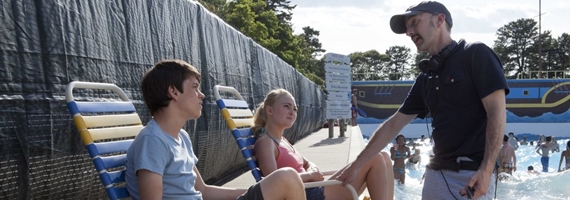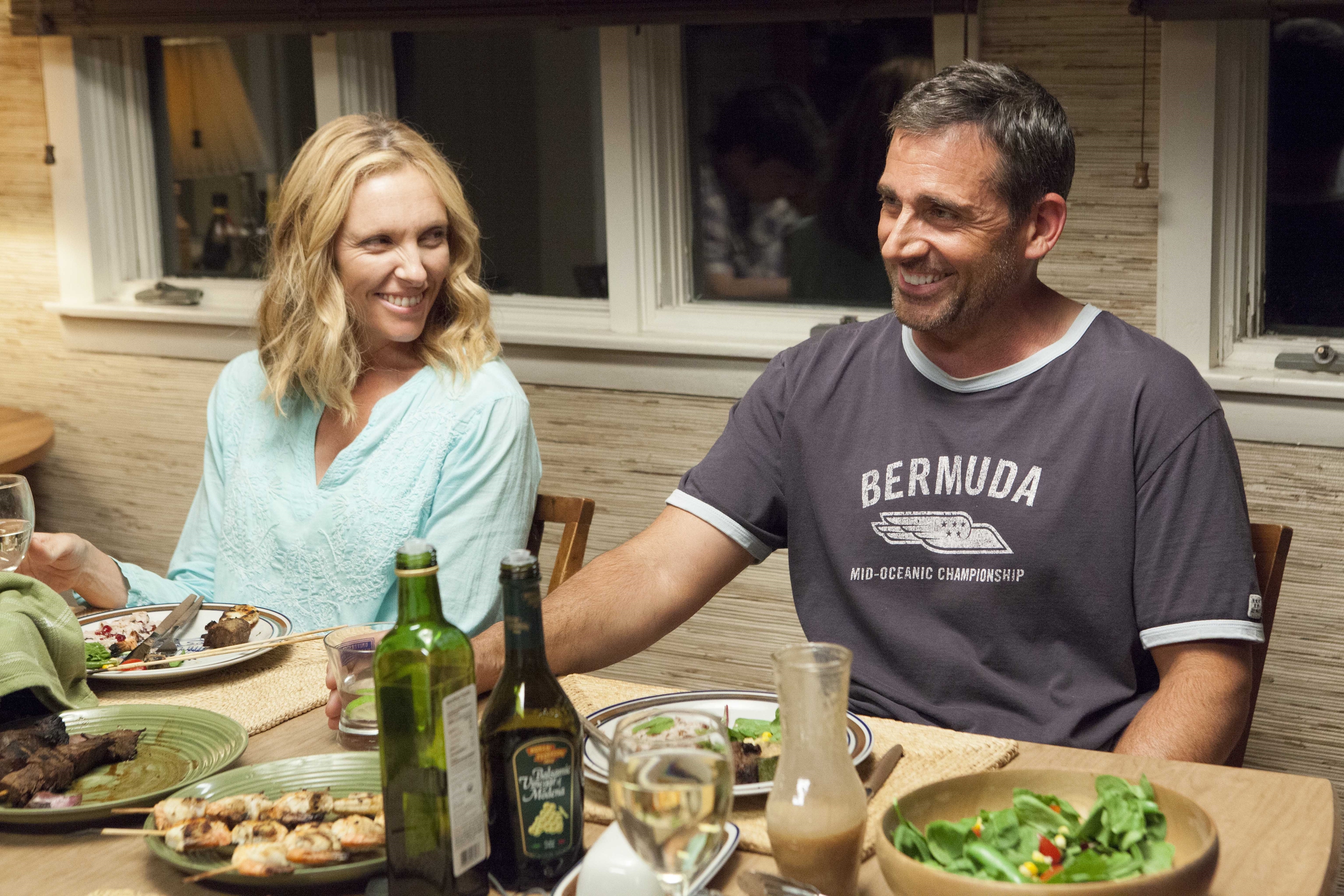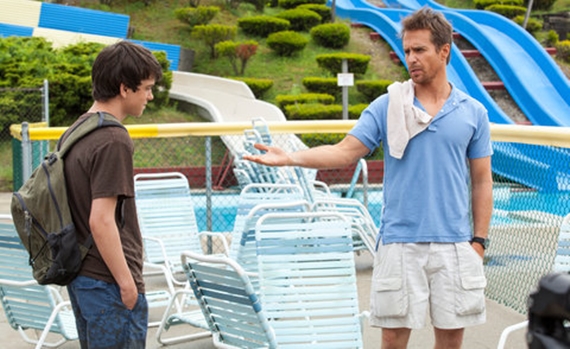
Click through to read the rest of my interview with Nat Faxon and Jim Rash or check out the first part of my write up here.
Being that The Way, Way Back took place in the summer, Nat and Jim were asked about their worst summer jobs were, before becoming actors. During junior high school, Jim was pushed into working construction by the father figures in his life. But because Jim had no special construction skills or was allowed to use the power tools, he found himself shoveling gravel, working for a company that was building a parking garage. When it came time to pour the concrete, he had the boring job of putting on rubber boots and wading in the concrete while holding the extension cord of the machine so it wouldn’t lay in the cement. He would stand for six hours behind other workers as they poured and aerated concrete. On the bright side, he said he was able to meet really interesting characters. Nat Faxon, however, had what both considered to be the worst summer job:
JR: You had the worst one
NF: I do, yeah I had a few. I would spend my summers on Nantucket Island in Massachusetts and the first job I ever had was collating newspapers at the local newspaper. And that meant going into the basement where the printing press was, sitting around a table with five elderly women and waiting for the first section to come out which would be the D Section. They would pile it up against one wall, along this entire wall, thousands of papers. Then the C Section would come out and we would then manually put the C Section inside the D Section and then fill the whole wall with that. And then the next section would come out and then we would take all those papers and put them on that side and then the cover, there was no radio allowed, phones weren’t really a huge, you couldn’t do anything with you phones and so it literally was just me, chatting with five ladies about what was going on on the island. It was four long days a week and I did that, I don’t know how I… I did not go crazy…. I think I did. And… yeah, that’s what led me to alcohol (laughs)
JR: Print it! Print it!
Nat put his empty Fiji bottle aside as he and Jim spoke about their favorite scenes from the film. Nat started, saying he loved the emotional scenes, particularly the good-byes. His eyes began to water and his voice cracked the slightest because despite seeing the film so many times, it always brings him a lot of emotions to him. And it’s not just the good-byes of the main characters, but the good-byes of the supporting characters too. It’s moments that stand out and just grab hold of him. Jim focused more on the silence of the film, particularly the dinner scene when the family is waiting for Trent and the after dinner scene as the family members are tidying up and doing the dishes. Not much dialogue is spoken and both were completed in one shot. It’s a fondness that came from the idea of how simple a set-up the scene was and how well restraint works when writing for a character or group of characters.
Jim and Nat discussed restraint and how it was used in directing The Way, Way Back. They only had 24 days to shoot the film and only camera to do it with. A lot of decisions and choices made, were due to the fact that they weren’t allowed five set-ups, they would only be allowed one. Nat enjoys the one set-up scenes more because they tend to stand out as more interesting. It’s at this point the blonde representative steps in informing us we have time for one or two more questions. THAT, and she has to steal Jim away for the rest of our interview.
NF: Where you going Jim?
JR: I don’t know, I think I’m in trouble… excuse me.
The room laughs and Nat looks me to, knowing I have the next qestions.
NF: Sorry.
ME: Oh no that’s-
NF: The smarter one has left the room.
Again, the room laughs.
ME: With the writing process, I recently listened to an interview with Seth Rogen and Evan Goldberg, they try to be in the same room at the same time when they write. Other writers they kinda send parts back and forth to eachother, what’s your guys’ process? Do you try to do a bit of both? Or do you have your own thing going?
NF: You know, for the most part we do a lot of things together, certainly when were coming up with ideas, least in the brainstorming stages, we’re going back and forth. When we first started writing together at the Groundlings, it was a lot of that… what about this? Yeah yeah yeah or what about this? Oh I love that, but, what about this instead. So, a lot of it is just us going back and forth, finding stuff that we both love or agree on or connect over. Then, same as we’re treating out the script, we’re treating out the ideas, getting more formal outline in a way, getting a map for ourselves. Then we’ll sit around and write together. We typically don’t send things back and forth or assign each other sections. We do it mostly together and on occasion Jim will, I’ll have to send him away… I think he has to take a second, I should say, probably because I’m annoying him or getting in his way sometimes, he is obviously the more neurotic one of the two of us and so he’s the type of person that needs to figure out the answer at that moment, whereas I’m like let’s figure this out tomorrow. Okay, and then he’ll go home and totally obsess over it, write, come in the next day and be like ‘Well I took a pass because I needed to figure it out” and usually it’s brilliant and I’m always the benefit of it. Then the rewriting phase is more of us doing it together. It’s a little bit of everything I guess, it’s certainly a mixed bag. Mostly it’s us doing stuff together.
The interview ended and I got the opportunity to take my picture with Nat, so I did. Who’s gonna pass that up? As I left the hotel room, I passed the next group of interviewers and I wondered how many were going after us and how many came before us. It didn’t matter. I rode the elevator down to the lobby and walked with the other interviewers, exchanging information and well wishes as I made my way to the lobby counter to ask a staff member what the appropriate amount it is to tip the valet when he brings your car back. It’s two or three bucks by the way. In case you were wondering. I drove through what felt like endless roads along rivers and forests as I found my way to the Interstate to make my way home. I didn’t listen to my iPod or the radio. I didn’t roll my windows down to listen to the sounds of DC. I didn’t get bummed because I couldn’t get my picture taken with Jim Rash. I thought.
I thought about the picture that was hanging over Jim and Nat in the hotel room. It was a grey brick courtyard, and the silhouettes of people were walking and looking at their shadows. I thought of the idea the picture was trying to get across. The idea that no matter who you are, it’s always good to stop, and look to where you’ve been or where you’re going. I thought of how Jim Rash was able to take sad moments in his life, put ink to paper and allow that moment to become a character in a film that others will identify and enjoy. I thought of how both Nat and Jim would callback to their meeting and work as part of Groundlings. I thought of who I was when I first joined French Toast Sunday and who I am now. I thought of French Toast Sunday and how the gang has done incredible work to bring it to where it is today and where it will be in the future. As I rode home, I felt like I was right where I needed to be.

Be sure to read the first part of my interview here and if you are interested in finding out more info on The Way Way Back you can check out the trailer here and the film’s website here.



